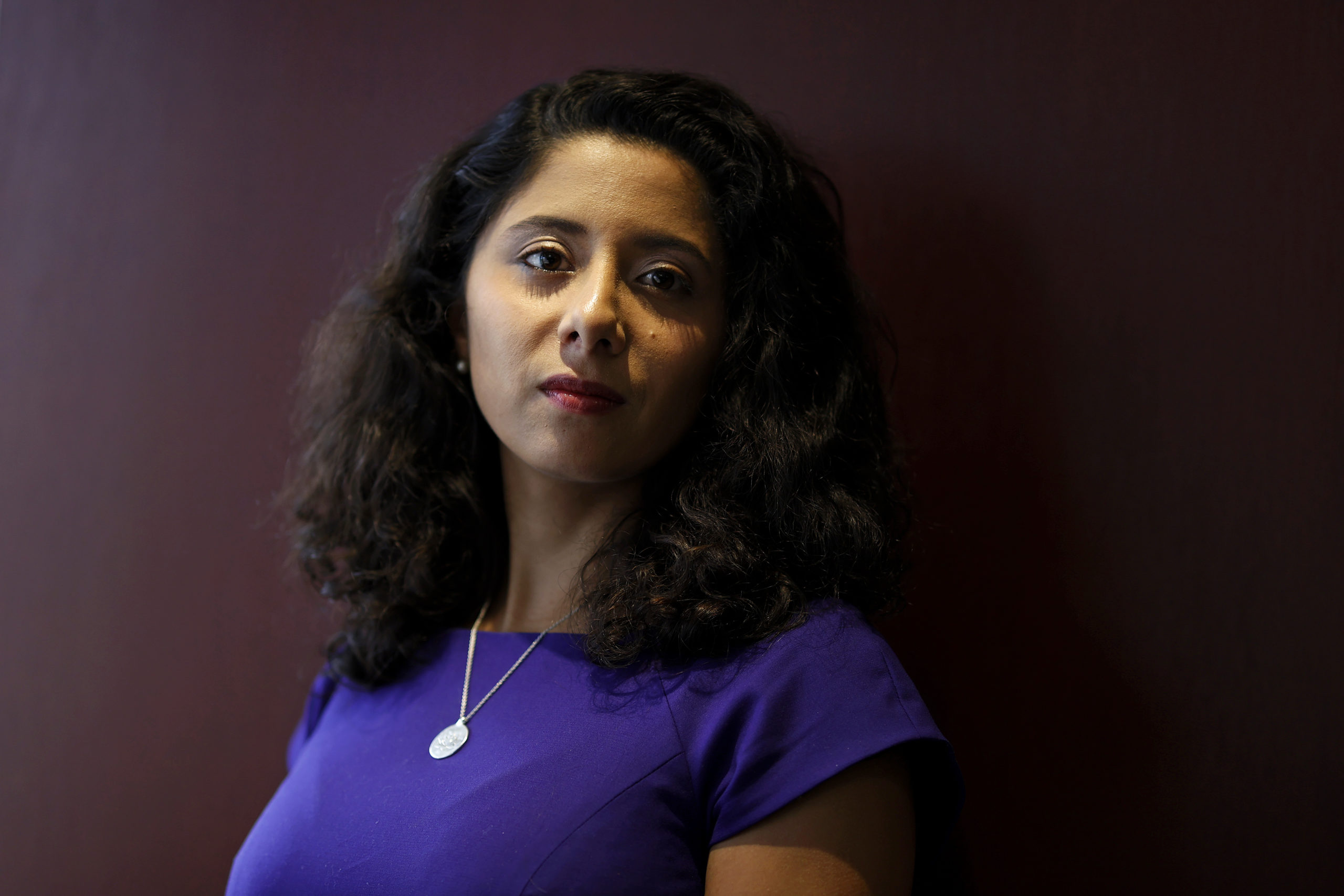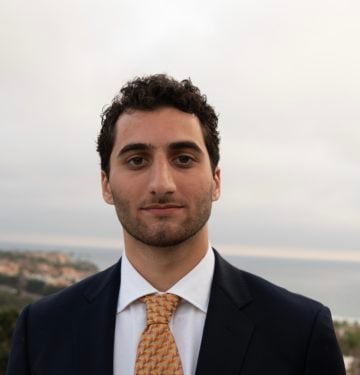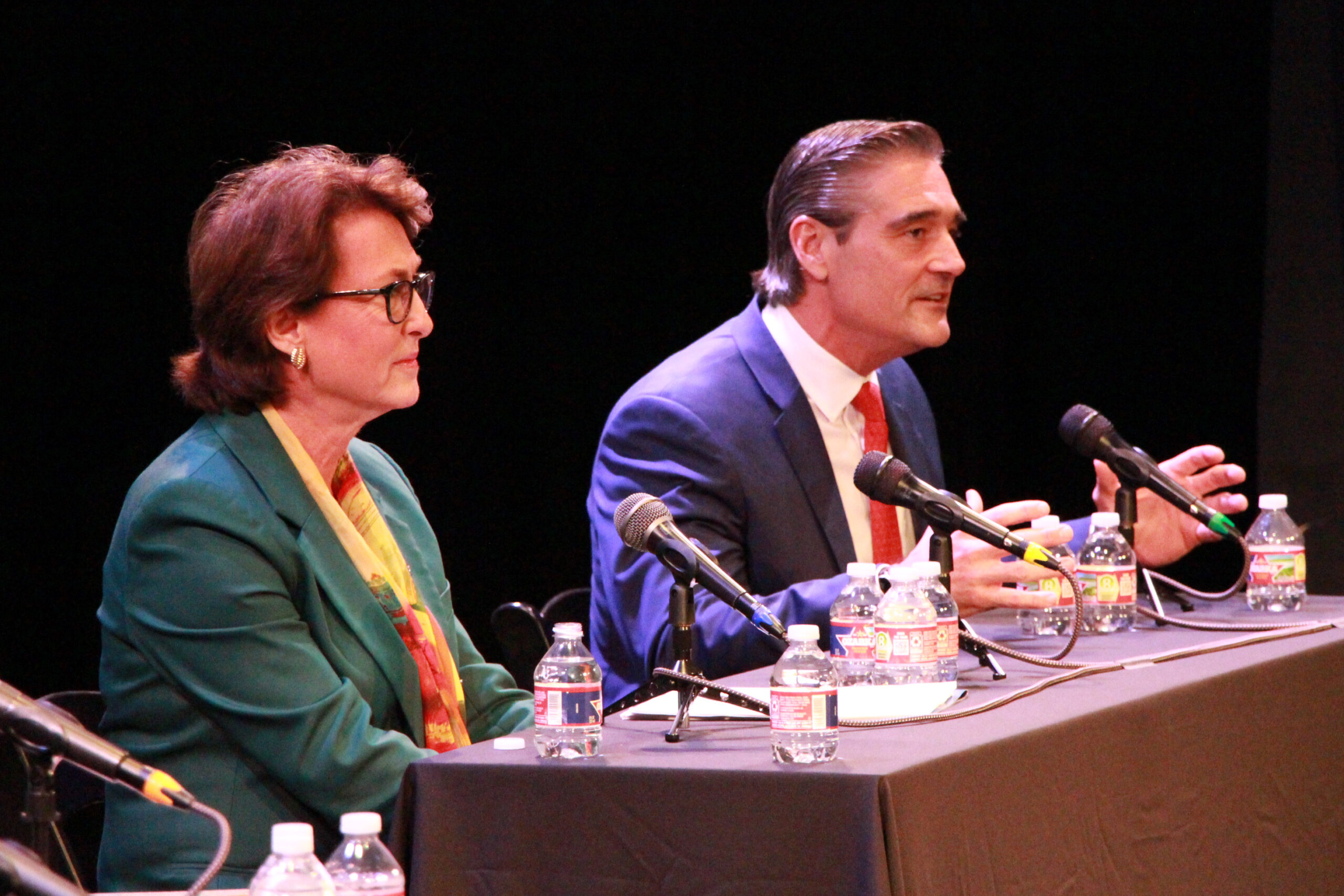
Crime, Statistics, and the Harris County Judge’s Race
In Texas’ most populous county, funding for law enforcement takes center stage.

Crime and public safety have often dominated political campaigns in Houston and Harris County, but perhaps never more than in this year’s county judge race, where polls show it is voters’ number one issue.
That’s despite the fact that incumbent Democrat Lina Hidalgo has presided over record levels of law enforcement funding and pushed to hire more sheriff’s deputies, in a job that otherwise has little control over the major law enforcement policy issues under debate. She did have a hand in new bail bond rules for nonviolent defendants—but despite claims from Republicans, those new rules have little to do with crime rates in Houston.
Hidalgo is facing retired Army captain and former investment banker Alexandra del Moral Mealer, who’s outspending her in a race that looks like a “statistical dead heat” according to the Hobby School of Public Affairs at the University of Houston. Along with two other commissioner seats that are up for grabs, the county judge race could determine whether Democrats maintain their 3-2 control or flip to Republicans. This high-stakes election will shape the political future of the largest county in Texas.
In Texas, the county judges who head the commissioners courts have few judicial responsibilities and their law enforcement role is limited to the funding, operation, and infrastructure of the criminal justice system. They are elected “chief executive officers of the county” and, with the commissioners, mainly manage the county budget, set property tax rates, build county infrastructure, and serve as directors of emergency management. Sheriffs, justices of the peace, and constables, who do enforce the laws or preside over legal proceedings, are independently elected. However, the sheriff’s department budget, as well as the district attorney’s and others in the criminal justice system, must be approved by the commissioners court.
Controversy over that budget began a political drama that will not conclude until election day. After the commissioners court ended the practice of “rollover” budgeting, which allowed county departments to keep leftover money for use the following year, some disgruntled constables felt Hidalgo and the court had “defunded” law enforcement during a period of high violent crime rates in the county, allegedly in violation of a state law passed in 2021 requiring that any move to defund police be put to public vote. Then in late August, State Comptroller Glenn Hegar accused Hidalgo of defunding the police and launched an investigation, setting in motion a three-month long battle over the budget.
So for six straight commissioners court meetings, Republican members Tom Ramsey and Jack Cagle didn’t show up in order to prevent the court from having a quorum present, thereby preventing Democrats from adopting a slightly higher tax rate than the Republicans’ proposal—a fight over a difference of about $16 on the average homeowner’s tax bill, according to a Houston Chronicle report. Mealer’s GOP allies were quashing an opportunity to further increase county law enforcement funding by about $100 million.
Meanwhile, Mealer and the Republican commissioners have been campaigning hard on what they say is a “full-blown crisis” of crime and “lawlessness” in Houston. She’s drawn overwhelming endorsements from the law enforcement community, like the Harris County Deputies’ Organization, which called Harris County “the most violent county in Texas, if not the United States.” In August, Pastor Ed Young of Houston’s Second Baptist Church called for citizens of “one of the two or three most dangerous cities in the world” to vote out the Democrats. More recently, Jim “Mattress Mack” McIngvale has appeared in ads supporting Mealer’s plan to address crime in Harris County.

Violent crime rates, bail bond reform, and the backlog in local courts are the public safety problems that people seem most worried about.
Crime rates in the Houston metro area have surged in recent years, along with many other major cities, due to what experts believe is a combination of factors including the pandemic and reduced citizen faith in law enforcement. In Harris County, violent crime rates went back down again last year and continue to fall this year, though they are still far higher than when Hidalgo took office.
From 2017, the year before Hidalgo took office, to 2019, violent crime (which includes murder, assault, rape, and robbery) was declining in Harris County. But in 2020, nationwide, violent crime increased, even though it had been steadily declining since the 1990s. Homicide rates in particular surged nationwide to 6.5 per every 100,000 residents. That was an increase of roughly 30 percent—the highest single-year jump in modern American history. The rate of firearm homicides reached its highest level since 1994.
Harris County followed the national pattern, as Hidalgo has acknowledged. The homicide rate went from 8.45 per 100,000 residents in 2019 to 11.96 per 100,000 residents in 2020, a rate that’s higher than the national average.
In 2020, Houston’s (not Harris County’s) 17.27 homicides per 100,000 wasn’t close to the most dangerous cities in the country and fared better than big cities like Philadelphia or Chicago, but it was higher than New York or Los Angeles. And it got even worse in 2021, with the worst homicide rate of any big city in Texas. (Data was compiled from crime analyst Jeff Asher.)
Since then, Harris County’s violent crime rate has so far dropped 12 percent compared to last year, though it’s above pre-pandemic levels and the levels when Hidalgo took office.
Still, statistics don’t seem to mean much to voters when it comes to crime. Regardless of reality, Americans have reported in every year but one since the 1980s (the exception was 2001) that they believed crime rates were going up, according to Gallup. And Hidalgo gets it. “If you’re a victim of crime, the crime issue can’t be big enough or talked about enough,” she told the Texas Observer.
Alec Karakatsanis, a civil rights lawyer and criminal justice activist, thinks that overperception of crime is natural in the current mass media environment. “You get this impression when you watch the local nightly news that there is this constant stream of crime always happening. It’s always increasing, when in fact, it’s not,” he said.
That “seemingly infinite ticker tape of suspect mug shots on the 10 o’clock news,” as the Houston Chronicle’s editorial board wrote, led them to endorse Mealer because she “seems to be listening to many in our community who otherwise feel unheard: crime victims and their families.” Hidalgo said she found the endorsement “baffling.”
To improve public safety, Mealer, who declined the Observer’s request for comment, argues that Hidalgo’s misdemeanor bail reform “policies” are “directly [the cause of] the rapid rise in crime” and wants to reverse them. In the gubernatorial debate, Governor Greg Abbott said that Harris County’s “easy bail policies” are “letting dangerous criminals such as people recently convicted of murder last year back out on the streets.”
What Mealer and Abbott are referring to regarding bail reform is the 2019 consent decree in a federal class-action lawsuit against Harris County, known as the ODonnell case, that stopped the jailing of poor defendants held on low-level, nonviolent misdemeanor charges simply because they couldn’t afford to post bail. Karakatsanis was lead attorney for four civil rights groups and individual plaintiffs who argued that the cash bail system violated accused persons’ constitutional rights by jailing defendants only because they were poor.
At that time, Harris County judges followed a rigid schedule for assigning bail and required almost every defendant to pay bail or stay behind bars pending trial.
In April 2017, a federal judge ruled for the plaintiffs and issued a preliminary injunction that made it possible for most persons arrested on minor, nonviolent misdemeanor charges to get out of jail without posting bail. The injunction was replaced by the ODonnell consent decree, adopted in November 2019, which eliminated the existing misdemeanor bail schedule, put in place a new local rule for handling pretrial releases, and implemented other institutional changes such as electronic court notifications.
The decree does not allow for the automatic release of anyone who has violated a restraining order, been arrested on a second DWI or any crime of family violence, or who was already out on a bond or probation when they were rearrested. In these cases, defendants face a traditional bail-setting process.
The policy wasn’t created by Hidalgo (although another commissioner actually urged the civil rights groups to file the suit)—but she presided over the commissioners court that voted to approve the settlement and, in a statement at the time, hailed the decision for “making our criminal justice system smarter, fairer, and more cost effective.”
Despite all the political backlash that followed, there is no evidence that Harris County’s pretrial bail reform fueled a spike in crime, the Quattrone Center at the University of Pennsylvania’s Carey Law School found in August. The reform lowered conviction rates (in part because many low-income defendants had been pleading guilty rather than spending weeks or months in jail awaiting trial), lowered the likelihood of jail sentences, and reduced sentence lengths, all without damaging public safety, the study concluded.
“You get this impression when you watch the local nightly news that there is this constant stream of crime always happening … when in fact, it’s not.”
One of the most prominent opponents of the reformed bail system was Harris County District Attorney Kim Ogg—who has repeatedly clashed with Hidalgo. Last year, she claimed that the incidence of violent crime committed by defendants out on bail had increased. But in March, court-appointed independent monitors found no evidence for Ogg’s claims. The “share of people arrested for misdemeanors who had new charges filed within one year following the initial arrest remained basically constant between 2015 and 2021,” wrote the independent monitor.
The misdemeanor bail reform is also connected to another big issue in this election—the court backlog.
As of October, Harris County had 40,450 active criminal cases awaiting court action and, as a result, a jail system bursting at the seams. Court backlogs were in part a result of Hurricane Harvey-induced flooding of the downtown criminal justice complex in 2018 and made worse by the pandemic. Overcrowding has forced the county to send 600 inmates to a Louisiana jail, and this summer it sent another 600 to Garza County.
Mealer has used the clogged courts and slow casework as yet another cudgel to bash Hidalgo and cast her as the main culprit for Houston crime. And it has fueled requests from Ogg to the commissioners for more funding to expedite the court process by adding staff.
The commissioners court has tackled the backlog by adding permanent and temporary judges, prosecutors, bailiffs, clerks, and personnel to process evidence that otherwise might delay trials, and relocated inmates, spending a combined $39 million on these efforts. Such measures have helped to decrease the backlog by 23 percent since January, according to a report by the Office of County Administration.
Rather than adding to the problem, Harris County Sheriff Ed Gonzalez says bail reform has helped ease the county’s chronically overcrowded jails. “Since misdemeanor reform has come into effect, our system is significantly less congested with low-level defendants,” he said in September. “If not for misdemeanor bail reform, we would struggle even more to find space for violent offenders who need to be in jail.”
One group that does have a connection to accused felons getting back on the street is bail bondsmen. The ODonnell decree cost bail bondsmen millions in potential revenue, explained Professor Sandra Guerra Thompson, a University of Houston Law Center professor who is also a deputy monitor of the consent decree. Now, she said, bondsmen are trying to make up those losses by charging lower nonrefundable fees to felony defendants, allowing them to be released without having to pay nearly as much as a full bond.
Mealer says she favors the federal system based on risk and not money bail, which is against the interests of the bail bond industry. In February, Hidalgo and the commissioners court voted unanimously to encourage the Harris County Bail Bond Board to require a 10 percent minimum fee on bond payments.
Mealer has also called for more law enforcement officers to be put on the street. But that’s already happening: Under Hidalgo’s leadership, the county has increased funding for constables, the sheriff’s office, and the district attorney each year she’s been in office.
At a commissioners court meeting on Wednesday, Ramsey and Cagle finally showed up and, in just 15 minutes, passed a no-new-revenue budget, ending the months-long budget fight—and killing the possibility of budget increases for county law enforcement.



